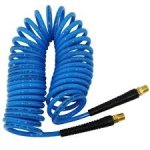The 4 hose system acts like a plenum. As Ddays stated, the restriction is the valve stem or more specifically the Schrader valve. So, the more volume your hose system has, the more it "absorbs" the pressure impulses from the compressor, causing the average pressure in the hose to be lower, leading to lower flow rate through the Schrader valves. If you want to validate this, put a tank between your portable compressor and a tire and try to fill the tire without pre-pressurizing the tank. The bigger the tank, the more time it will take to fill the tire.
In theory, using one short hose of small, yet big enough, diameter, will fill the tire faster than 4 long hoses of the same diameter. In practice, it may be a wash, due to having to uncoil and attach all the hoses and then coil and stow all of them.


